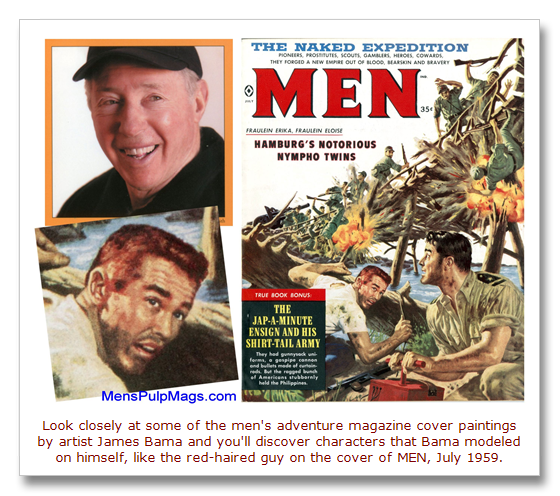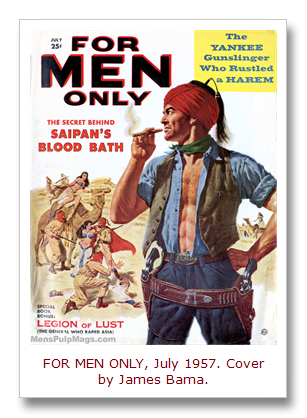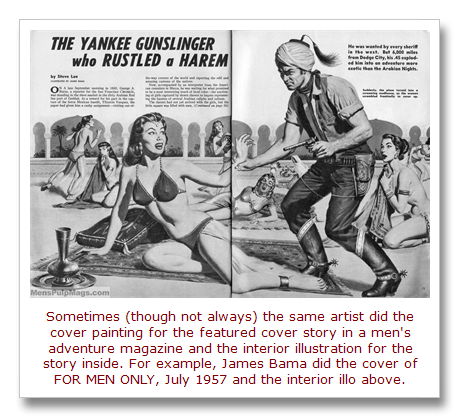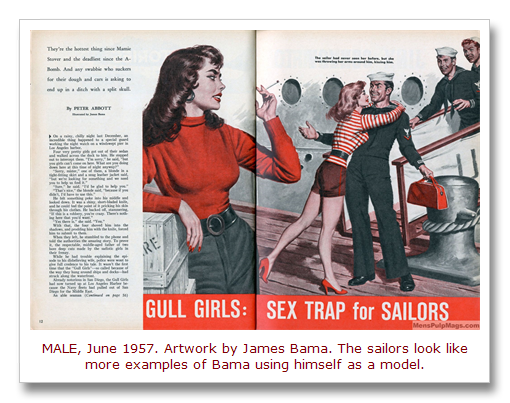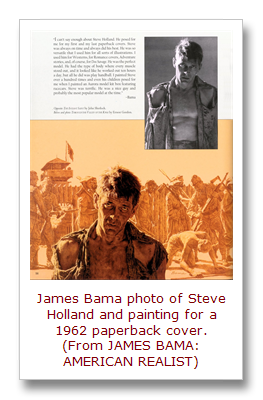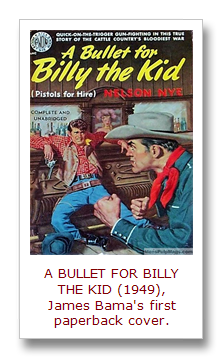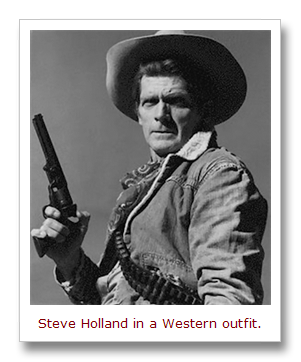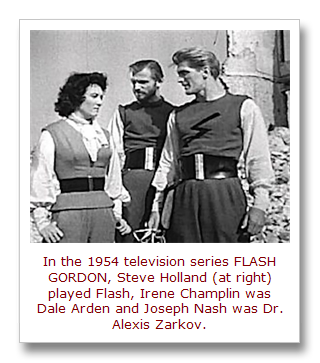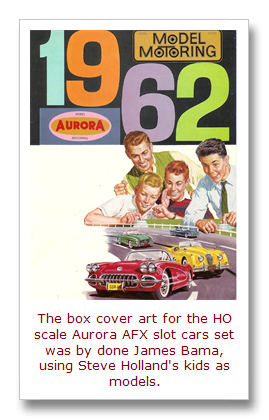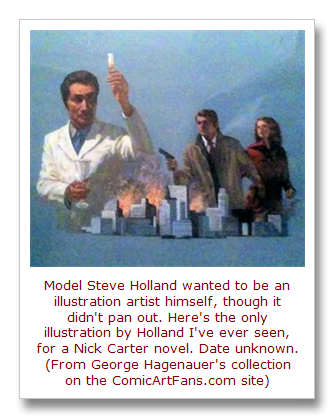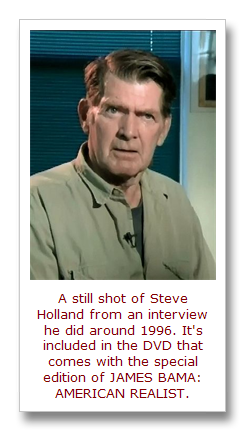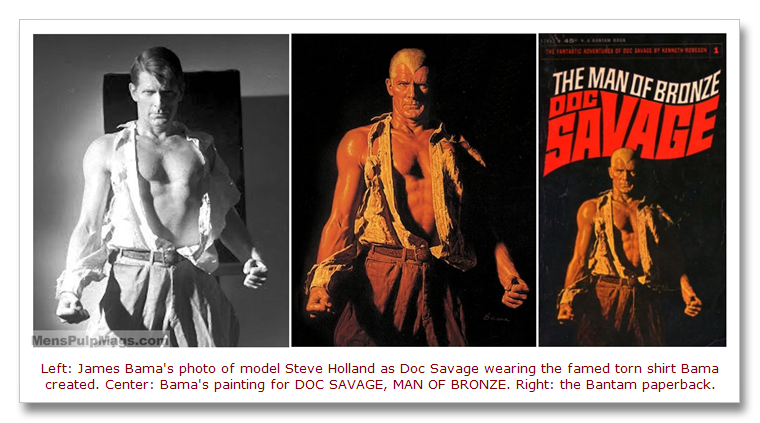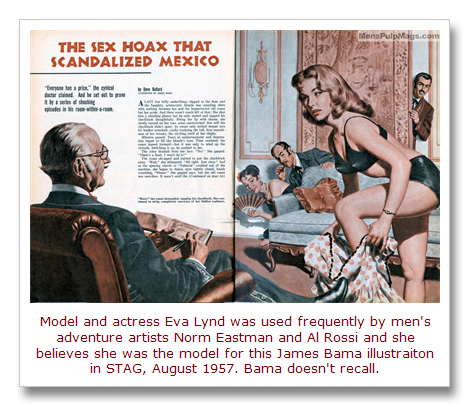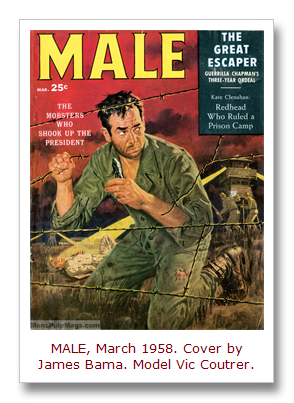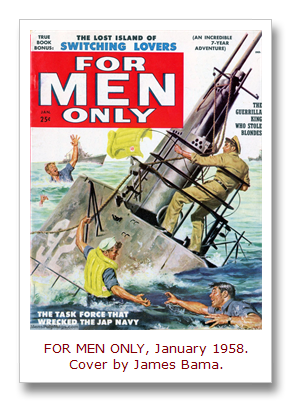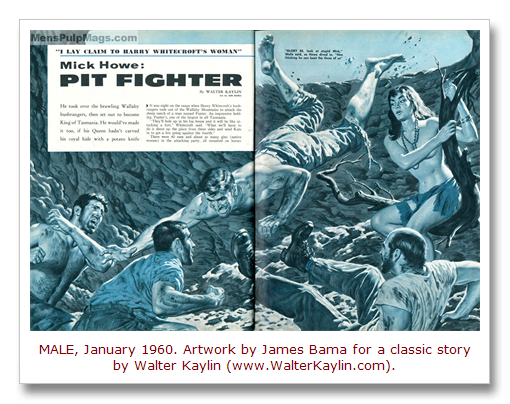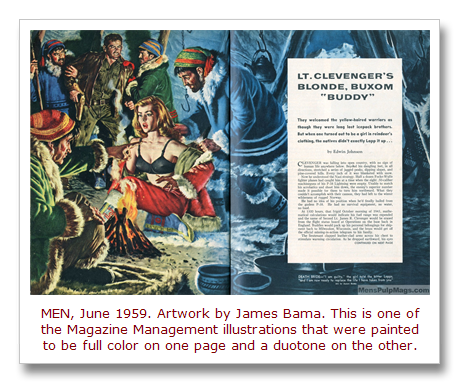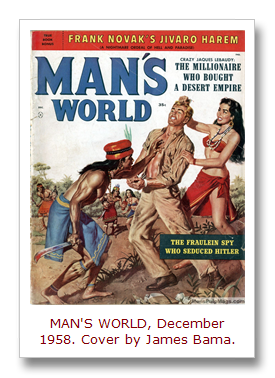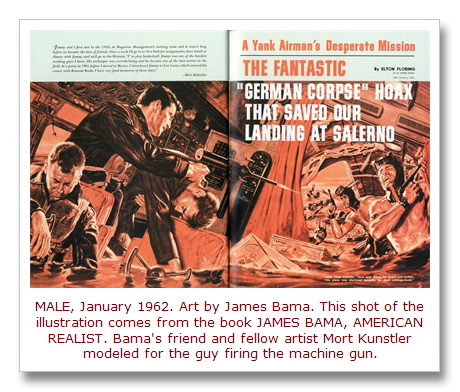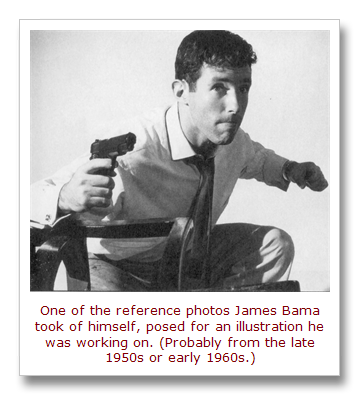AN UPDATE with new info from Brian M. Kane, author of the must-have book JAMES BAMA: AMERICAN REALIST …
In April 2021, there was a discussion among members of the Men’s Adventure Magazines & Books Facebook Group about the female model Bama posed with Steve Holland in the reference photo he used for his famed cover painting for the 1967 Bantam paperback edition of Robert H. Rimmer’s novel THE HARRAD EXPERIMENT.
When I talked with Jim for this interview back in 2014, he misremembered and said the female model was actress Andrea Dromm. In fact, Brian Kane said Bama used his wife Lynne Bama in the reference photo for THE HARRAD EXPERIMENT. Jim and Lynne met in 1963 and were married in 1964. Brian said she modeled for many of Jim’s paperback cover paintings and was also the model for the Witch in his box cover art for that Aurora model kit.
Brian noted that Dromm only posed for two of Bama’s paperback cover paintings. She was the model for his cover painting for the 1967 Bantam edition of THE HELLER by William E. Henning. (In his cover art for the 1970 Bantam edition of THE HELLER, Jim used his wife Lynne as the model.) The other cover painting Bama used Dromm for was the 1965 Bantam edition of TOMBOY by Hal Ellson.
* * * * *
A while ago, I posted Part 1 of a transcribed phone conversation I had with James Bama, one of the greatest of all of the many great artists who spent a portion of the careers doing illustration art for men’s pulp adventure magazines in the 1950s, 1960s and 1970s.
Near the end of that post, Jim explained that after serving in the US Army Air Corps during World War Two, he used the GI bill to go to art school.
Like many top illustration artists of the second half of the 20th Century, he studied under the legendary art teacher Frank J. Reilly at the Art Students League in New York.
Some of the other students of Reilly who, like Jim Bama, went on to do classic illustration art for men’s adventure magazines and pulp paperbacks include Stan Borack, Mel Crair, Ed Emshwiller, Basil Gogos, Roger Kastel, Robert Maguire, Lou Marchetti, Frank McCarthy, Rudy Nappi, Robert Schulz.
(For more about Frank Reilly, I recommend the fascinating essay about him by pinup artist and art historian Kent Steine, posted on the American Art Archives site.)
MensPulpMags.com editor Bob Deis: It’s truly amazing how many great illustration artists studied under Reilly.
James Bama: Well, Frank Reilly probably produced more students who could make make a living at art than anyone. He was the most popular teacher at the League and I was one of his best students. I used to substitute for him in classes after I was there for a while.
He died in 1967, before he could see how famous and successful you would become. But I think I can see his influence in every facet of your work.
Bama: Yes, I had great training from Frank. Both of my parents had died and Frank was almost like father to me. He and his wife were very nice to me. I used to work all night with him on jobs when I was still in art school. I also used to work on commercial art jobs with him.
I’ve read that two of your other big influences were comic strip artists: Alex Raymond, the creator of Flash Gordon and Hal Foster, who created Prince Valiant.
Bama: Yes, I was four months shy of eight years old when Flash Gordon came out in 1934 and I kept copies of that comic strip for 10 years until I was 18. I’d go to the candy store every Sunday and wait for the newspaper truck to come. I must have known how good he would be. Alex Raymond grew and grew and grew as an artist. He was incredible, and he was my first hero. I loved Hal Foster’s comic strips, too. In fact, I originally wanted to be a cartoonist. I used to copy comic strips all the time, like Flash Gordon and Tarzan…
Hal Foster also drew the Tarzan comic strip in the ‘30s.
Bama: That’s right. So, I wanted be a cartoonist and as a teenager I managed to get a job working for Burris Jenkins, Jr. who was one of the two leading sports cartoonists in the country. He worked for Hearst, for the Journal-American, an afternoon newspaper in New York. When I was 15 years old I did my first original artwork. I sold an aerial view of Yankee Stadium to The Sporting News for $50. Jenkins was too busy to do it. I worked for him when I was 15, and then I was offered two jobs when I was finishing high school with Jimmy Hatlo, who did the comic “They’ll Do It Every Time,” and Bob Oksner, who did a detective series whose name I don’t remember, before going on to work for DC Comics. So, I was doing those two jobs and I had even worked up my own comic strip, “Mr. Faith.” But then the war happened and I went into the service, then I got the GI Bill and went to art school and wound up being an illustrator. But I always wanted to be a cartoonist. And, Alex Raymond and Hal Foster were my two biggest influences when I was a kid. Ironically, I wound up writing the introductions to books about both of them. What are the odds on that? [EDITOR’S NOTE: The books are ALEX RAYMOND: HIS LIFE AND ART and HAL FOSTER: PRINCE OF ILLUSTRATORS, FATHER OF THE ADVENTURE STRIP.]
And, ironically, your favorite male model as an illustration artist, Steve Holland, played Flash Gordon in the FLASH GORDON TV series in the ‘50s.
Bama: Yes, and I knew him before he was Flash Gordon. It was in 1954, I think, when he made the TV show in Germany. It had those terrible sets.
I read in the great book about you, JAMES BAMA: AMERICAN REALIST, that you met Steve in 1949. But it doesn’t say how you met him.
Bama: Well, Steve was already a model then and I booked him in 1949 for my first paperback cover. It was called A BULLET FOR BILLY THE KID. That was first paperback I ever did. I think they sold for 25 cents or something like that, and I booked Steve.
How did you find Steve Holland? Did he have an agent?
Bama: Well, that’s a good question. All the models had sheets with pictures of them and the agencies would send them out to everybody. I don’t remember how I got a hold of his, but I did.
And that was a couple of years before you started working at the Cooper Studios agency doing advertising art?
Bama: Yes. And, then we became good friends and Steve modeled for me more than anyone. We were friends until the end. I knew his wife and kids, too. I used his boys as models, with race cars and tracks, for an Aurora race car set box cover. They posed for me over at Steve’s apartment. He died in 1997 and he was only about a year older than me. I thought we were the same age, but I just did an article about him for Anthony Tollin and Brian Cain, 150 words describing Steve Holland, for one of their new Doc Savage reprints. Steve was a terrific model and after I used him for all the Doc Savage covers I did, he became known for that. But, ironically, he was also Flash Gordon, and the Flash Gordon comic was one of the biggest influences in my life.
It’s very cool the DVD in the special edition of AMERICAN REALIST includes an interview with Steve Holland talking about you that was taped before he died. I read somewhere that he wanted to be an illustrator himself.
Bama: Yeah, in fact I gave all my files to Steve when I left New York to move to Wyoming in 1968. He had started doing illustration and I left all my files with Steve. We were very good friends.
Your reference files?
Bama: Yeah.
Another artist I interviewed who did a lot of work for men’s adventure magazine, Bruce Minney, told me he collected drawers full of files of reference pictures that he cut out of magazines. Is that what you did?
Bama: I know Bruce’s name but never met him. Yes, I had a bunch of reference files and that’s where they all were from, magazines, and I gave them to Steve when I left. And, here’s a funny thing about him. You’ll appreciate this. I created that ripped shirt he wore as Doc Savage. I remember when I was a teenager my uncle was a cab driver and when my mother died I moved in with my two aunts and my uncle. He used to buy pulp magazines and he gave me his Doc Savages. I still remember the first Doc Savage pulp cover I saw. He had a ripped shirt and was in the jungle [in a cover painting by Walter Baumhofer], and that’s how I conceived the shirt for my version of the character. So, I ripped up a shirt and gave it Steve Holland to wear and it worked great. And, we kept using it for years. Then, when I moved to Wyoming in 1968 I left the shirt with Steve, along with the pants and the boots we used for Doc. Well, after I moved, his daughter was cleaning the house, his apartment, and she thought shirt was a dust rag and she threw it out. For a while after I moved to Wyoming, I was still doing Doc Savage covers, So, Steve had to create another one, which wasn’t quite like the one I made. Anyway, that’s the story of his ripped shirt.
Steve Holland was used by so many illustration artists. Do you think he made a good living as a model.
Bama: Well, I don’t know how to evaluate that. I paid him $25 an hour and he never raised his hourly prices. I don’t think he got rich, but I think he did pretty well. I don’t think he was money hungry.
Did you use any other male models on a regular basis?
When artists were doing work for some of the top magazines, like the Saturday Evening Post, or the women’s magazines, they usually used different kinds of male models. But he worked for just about everybody who was doing the men’s adventure paintings and paperback covers. I also used Vic Coutrer. He’s the one cutting the wire fence at night for a cover painting I did for MALE. He modeled for me. So did Burke McHugh, who was gay. He was very good for advertising. He was like the father type.
One of the female models I’ve interviewed and gotten to know is Eva Lynd. She did a lot of modeling sessions with Steve Holland for men’s adventure and paperback covers done by artists Al Rossi and Norm Eastman.
Bama: I don’t remember using her.
Eva and I think we’ve IDed at least one interior illustration by you that features her.
Bama: Could be, I don’t remember. I used a lot of models, though I used certain models over and over again. I used my wife Lynne a lot for paperback covers. I met her at a party in 1963 and we got married a year later. I also used Andrea Dromm.
You noted in AMERICAN REALIST that one day Lynne would pose as a hooker, like she was for the cover you did for the book MIDNIGHT COWBOY, and another day she’d be a nun. And, Andrea Dromm was on some of your popular Bantam covers, like TOMBOY and THE HELLER.
Bama: That’s right. But I can’t remember the names of most of the other female models I used, I used so many. In New York back then, you got to meet all kinds of people who were modeling part-time. Some made it big and some didn’t. I do remember using the actress Maggie Pierce for some advertising art and she wound up being the lead in the TV show MY MOTHER, THE CAR, which I never saw. I tried to date her. That was before I met Lynne. Maggie had been a nurse and she was a real American girl. I used her quite a bit as a model, but she turned me down for a date. Then all of a sudden, one day out of the blue, I was working and she called me up and she said, “Let’s go to the movies together.” So, the movie DIABOLIQUE was playing and I was supposed to meet her in front of the theater and she never showed up. To this day, I never heard from her. That’s what they’d do to you.
Did you do all your own photography of the models?
Bama: Oh, yeah. I did all my own photography, all my own. I posed the models and arranged the lighting and everything.
From the early-1950s to the mid-1960s, you did advertising art at Cooper Studios during the day and illustration art for magazines and paperbacks at night and on the weekends. Did you do the photography sessions for that work at Cooper’s?
Bama: Yes. Then when Cooper folded, I would do it at home. Steve Holland and other models used to come up and pose for me at my house.
How long would a modeling session last?
Bama: Well, we would usually book a model for an hour, but it didn’t always take that long. When I moved out here, I kept doing all my own photos, all the ones I used for my Western paintings. But for a while, I was still doing Doc Savage covers after I moved to Wyoming and I couldn’t bring Steve out here to photograph him. So when I’d go to New York to take my Western paintings to galleries, I’d take a whole bunch of stock shots of Steve as Doc Savage in different lighting and different poses and I used them on the final covers I did for the series, even though I didn’t know what all the scenes would be. I did 62 Doc Savage covers in all and Steve was on every one of them.
Did you also do your own processing of the film?
Bama: Only in art school. We had a darkroom in the bathroom there. At Cooper Studios we had a photographer who did all the processing and printing for us.
So would you get them back the next day or would it take days?
Bama: We were always on his back. No, it was right away, we’d get contact sheets and then we’d pick out enlargements, and go as fast as he could do them because we always had tight deadlines. Everything was a deadline for magazines. It was due yesterday.
After you got the photos, did you show sketches to art directors of the men’s adventure magazines, or just bring in the finished paintings?
Bama: For the men’s adventure magazines I didn’t do sketches and I never redid anything. They didn’t ask for changes. I was too good. But in advertising – oh, they gave you fits. Between the salesman and the art director and the client, you’ve got all kinds of different directions. One wanted one thing and one wanted the other. And, they never paid you for corrections. So finally I would refuse to do more changes and eventually I stopped doing advertising art. I remember I did an American Standard air-conditioners ad. It was the outside of a house, a wooden house, and it was at night and it was in a blue moon, the house, and inside the family was watching television. That was bright colors. The art director wanted me to paint the house bluer and then the client didn’t like it blue and he wanted it back the way it was. They give you fits and that’s one reason I quit. The paperbacks never gave me a hard time because I made millions of dollars for those people. The cover I did for THE HARRAD EXPERIMENT sold something like three million copies. I did covers for a lot of books that made millions of dollars, including four Pulitzer Prize winners.
Your men’s adventure magazine illustrations have the same dramatic lighting as many of your famous paperback covers and your Western paintings, but the brushwork seems less textured.
Bama: That’s because for the men’s adventure magazines, I worked with fast-drying, water-based paints on illustration board because of the deadlines. My paperbacks and fine art paintings were almost all in oil. When you work in oils, the paint is thick and you work on a textured surface. When you work in water-based paint, the paint is thin and you work on an illustration board, which is smoother.
Did you use gouache for the men’s adventure art?
Bama: No, I didn’t use gouache. I liked to use tempera.
All of your cover paintings for the men’s adventure mags are in color, of course, and some of the interiors you did were full color. But many of them were duotones. Did the Art Directors tell you which tones to use for the duotones?
Bama: Yes. They didn’t vary them much in an issue. A lot of the duotones I did are warm-colored. By the way, for one of the duotones shown in my AMERICAN REALIST book, Mort Kunstler posed for me. He’s the guy firing a machine gun inside a plane that was sinking. Another guy was slumped over the steering wheel. The plane was sinking and a couple of Nazis were coming in from the water. Mort’s in profile firing a machine gun. I think it’s the only time I used him as a model. He was very good looking. And, he wrote a nice thing about me that’s on the top of that page in the book.
That’s the story titled “German Corpse Hoax.” And, I notice that the Nazis all look like –
Bama: Yeah, they were all Steve Holland.
Steve Holland appears to have been used for multiple characters in a lot of illustrations in men’s adventure magazines done by you and other artists.
Bama: Yes, I would use Steve for multiple people for men’s adventure paintings. The magazines didn’t pay enough to book too many models. Sometimes I did book Steve and use some other artists as models in the same scene. At Coopers Studio, I worked with 45 other artists and so I had all of them available to me. In my men’s adventure illustrations, most of the men are either Steve Holland or my fellow artists at Coopers. I also used my best friend, Larry Leibowitz. He was retired and had plenty of money. After World War Two, he and his brother built homes like Levittown and they both retired pretty young. His father was Judge Samuel Leibowitz, who was famous. When he was a lawyer, he went to defend the Scottsboro Boys down south, and Quentin Reynolds wrote a book on him called COURTROOM. He also defended a lot of gangsters. He was a brilliant lawyer and was a judge for many years. Anyway, his son Larry was Hollywood handsome and he posed for me for many book covers and men’s adventure magazine illustrations. But not as many as Steve Holland. Steve was the best.
– END OF PART 2 –
Here are links to PART 1 and PART 3 of my interview with the great James Bama…
* * * * * * * * * *
Comments? Corrections? Post them on the Men’s Adventure Magazines Facebook Group.
Related reading…


